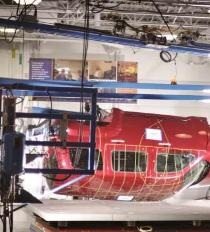Reprinted from Unbound, the Engineering School magazine
July 13, 2012 — According to the National Highway Traffic Safety Administration’s latest compiled traffic safety statistics, 32,885 people died as a result of motor vehicle crashes in the U.S. in 2010, while more than 2 million were injured.
The good news is that the number of people being killed in car crashes is actually dropping – to lower than it’s ever been since the NHTSA started keeping track in 1975. Part of the reduction and continually growing safety awareness can be attributed to the Center for Applied Biomechanics in the University of Virginia's School of Engineering and Applied Science. It’s where crash survival becomes a science.
As the largest university-based injury biomechanics laboratory in the world, the center specializes in impact biomechanics for injury prevention. Started by NHTSA back in 1989, the center now operates out of a 30,000-square-foot facility located in the University of Virginia Research Park. It is recognized as one of the world’s leading research groups in the field, using state-of-the-art equipment to analyze the intricacies of how the human body responds to injury.
The centerpiece is the first university-based full-scale rollover sled system – capable of rolling a sport utility vehicle at 400-degrees per second and dropping it onto a moving roadbed. Crash tests are captured on film at more than 1,000 frames per second, while a person’s motion during impact is tracked with submillimeter resolution.
“We study how the body behaves under impact circumstances,” said center director Jeff Crandall, who’s also a professor of mechanical and aerospace engineering and biomedical engineering. “When research we’ve done gets implemented and injury countermeasures continue to increase, the number of lives being saved adds up as time grows. We see where these changes make a real difference.”
With a 30-person research staff, as well as the assistance of 20 graduate students, the center performs a wide range of injury-prevention research for first responders, EMS, police and military personnel. Groundbreaking studies have involved out-of-position air bag injuries, as well as a collaboration with the U.S. Centers for Disease Control and Prevention that became the foundational study behind the American Academy of Pediatrics recommending that children stay rear-facing in car seats beyond age 1.
The center has also become one of the leading academic institutions on pedestrian safety. Of the 1.2 million global traffic fatalities every year, more than 700,000 are pedestrians. There is also multi-disciplinary collaboration with the School of Medicine.
“We’re giving doctors the opportunities to see very rare, severe injuries on a frequent basis in a controlled fashion,” Crandall said. “This ultimately helps with diagnosis and repair.”
Media Contact
Article Information
July 13, 2012
/content/biomechanics-center-saving-lives-highway

